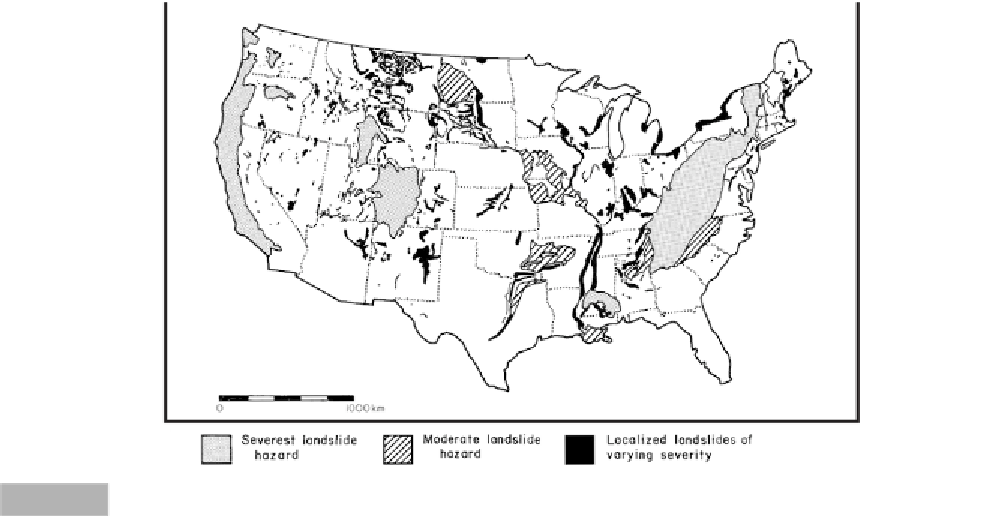Geoscience Reference
In-Depth Information
The ubiquitous nature of landslides is illustrated
with reference to the conterminous United States in
Figure 12.15. By far the most prevalent zone for
landslides occurs in the Appalachian Mountains in the
eastern part of the continent. Second in importance
are the Rocky Mountains, particularly in the states of
Colorado and Wyoming. The coastal ranges along the
Pacific Ocean form the third most hazardous zone. In
January 1982, heavy rains triggered more than 18 000
landslides in the San Francisco Bay region, causing
25 deaths and more than $US100 million in damage.
It was the third biggest disaster in this region after
the 1906 San Francisco and 1989 Loma Prieta earth-
quakes. The threat is even greater in the Los Angeles
region. Landslides in the Los Angeles area killed 200
people on 2 March 1938. In all, landslides in some
form affect about one-seventh of the United States.
While most of the failures happen in mountainous
areas, they are not restricted to these zones. The
Mississippi Valley has a low, but significant, risk, as do
plateaus on the southern Great Plains where weak
shales are found. The United States is not unique in
this respect. Landslides are a common geomorphic
process in most countries with steep or raised terrain.
rock cliff-faces but can occur in certain unconsolidated
sediments that permit vertical slopes to develop.
Generally, the vertical faces must be continually main-
tained by erosion of talus and screes that form at the
base of cliffs. If this debris is permitted to accumulate,
then the vertical face becomes buried. The debris is
removed through chemical breakdown, washing out of
fines and slippage. There is, thus, a balance between
the rate of cliff retreat controlled by the occurrence
of rockfalls, and the rate of removal of debris at the
base. The production of talus does not have to occur
catastrophically, but instead debris can simply accumu-
late through the continual addition of material as it is
loosened from the cliff-face by weathering, rainfall,
small shock waves, or frost action.
The preservation of a vertical face is dependent
upon the characteristics of the bedrock. Generally,
less resistant rock such as shales will not be able to
develop cliff-faces, because the rock is susceptible
to weathering and slippage. Situations where there are
massive beds of sandstone or limestone, or where these
resistant beds overlie weaker beds, are ideal for the
formation of cliffs. However, massive beds without
much jointing do not erode easily, and hence do not
produce rockfalls. For example, the escarpments along
the east Australian coastline have faces up to 100 m or
more high in places, and appear to be retreating at
rates as low as 1 mm yr
-1
without significant rockfalls.
Significant joints or vertical failure planes should also
Rock
falls
(Scheidegger, 1975; Voight, 1978)
Rockfalls are one of most rapid land-instability events.
They are generally restricted to unvegetated, vertical,
0
1000 km
Severest landslide
hazard
Moderate landslide
hazard
Localized landslide of
varying severity
Extent of landslides in the coterminous United States (after Hayes, 1981).
Fig. 12.15










